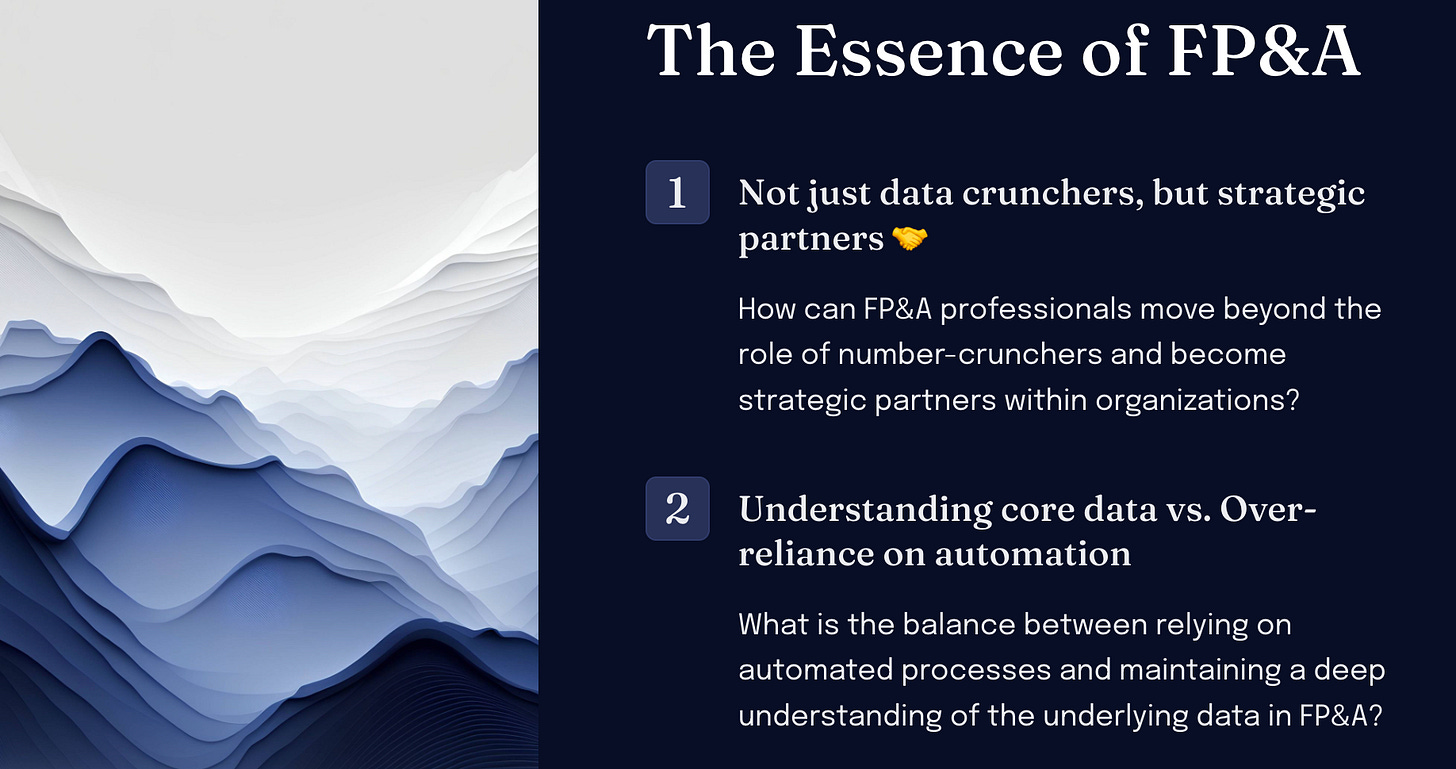The Friction Paradox in FP&A
Should we aim to remove friction or does a little resistance lead to better insights?
While working on a scenario analysis last week, I found myself impatiently waiting for the data query to finalize (it took more than 10 seconds, by a lot…). From one hand, I felt justified in my thoughts that “somebody” should configure the BI solutions in a more efficient way. But really, it’s actually odd, considering that not long ago, waiting for an IT request took weeks and now waiting for a few minutes is annoying. The possibility of having instantaneous results at our fingertips, is diminishing our tolerance for any form of delay.
The experience made me reflect on two articles I recently came across - Scott Belsky wrote in Edition #9 of Implications about “Our Declining Tolerance for Friction”1 and Fabrizio Dell’Acqua he found in his research paper that recruiters were “more likely to free-ride when the quality of algorithmic advice is too high.”2 So, we have both an increasing intolerance towards friction, but we will become lazy when there is none?
This got me thinking: how does this increasing impatience apply to the world of FP&A? In this piece, I'll explore the good, the bad, and the balance of friction from the perspective of FP&A.
The Current Landscape
In today's digital age, we as finance professionals, like everyone else, have become accustomed to instant solutions. An increasingly impatient business overall and evolving business requirements have changed our perspectives. Remember the last time a slight delay in your data visualization tool annoyed you or when a stakeholder demanded real-time financial insights?
As Scott Belsky aptly remarked, "The more friction software eliminates from our lives, the more intolerant of friction we become." reminding us that our personal interactions with technology inevitably influence our professional expectations.
The Positive Side of Friction
At the surface, the trend towards instantaneous, frictionless operations sounds positive. But let's pause and reflect on a specific FP&A experience. Consider a scenario where your automated forecasting tool projected some anomalous results. Aside from fixing the anomaly you actually then understood even better how the inputs impact the outcomes. This "friction" in having to manually analyze the data flows ensured relevance.
Belsky's words resonate here: "Friction makes us feel experiences as they happen." In the realm of FP&A, these moments of friction can be pivotal. They take us out of the routine and compel us to critically assess automated outputs and help validating the appropriateness of our financial models.
Understanding the Details
The ease provided by modern tools is undeniably beneficial. But there's a lurking danger: FP&A professionals becoming estranged from the core financial data. Simply put, automation shouldn't replace understanding. An FP&A professional isn't just a data cruncher. We're strategic business partners, shaping the organization's direction with our insights. And to offer valuable insights, we must understand the intricacies of our data.
The balance is crucial: leverage modern tools for efficiency, yet stay connected to the data. It couldn’t be that as an FP&A professional we would start pointing at “IT” or “data source” as the cause of our flawed analytics. The data is never perfect, therefore we need to know how we can work with the data in a way that gives relevant outcomes in a timely manner to be able to have valuable business discussions.
Resilience and Dependence
As we further eliminate friction, we must also consider the potential threats to organizational resilience. Recall a time when an over-reliance on a tool backfired. Perhaps a tool update disrupted your entire financial reporting process, or maybe a software malfunction led to frantic last minute guesswork. Such instances are stark reminders that while these tools enhance our efficiency, total dependence makes us vulnerable.
First of all, we should ensure that our tech stack itself is resilient and has fast time to recovery. However, we ourselves need to remain adaptable and prepared for unexpected hiccups. Possessing business acumen and building trust are our lifelines, often helping us navigate complex situations using minimum viable solutions. Remember, precision isn't about 100% accuracy; it's about confidently communicating the range you believe in.
Future Prospects
As we look forward, the shift towards frictionless operations will undoubtedly continue. However, for FP&A professionals, the challenge isn't merely adopting every emerging tool or trend. It's about selecting innovations that truly enhance our value. Our aim should be to evolve from mere "dashboard monkeys" to genuine business partners. Indeed, while we should actively explore opportunities, we must acknowledge that the future will both diverge from our expectations as well as differ from our present reality.
The aim should be to spend less time on manual data transmission, more time engaging with the business to gain deeper insights, and consistently maintaining a balance between efficiency and genuine understanding. Is there value in struggling days to complete calculations in a financial model? Just as we value a meticulously crafted artwork that took years to create over a quick AI-rendered imitation, should we really boast about a cumbersome 180-day budget process? Perhaps not. Yet, a 30-second AI-generated company budget might bypass crucial learning experiences for a finance business partner. But what if a 30-second budget update is the future?
In conclusion, while we continue on a relentless pursuit of productivity, let's not forget the value that a little friction can bring to our roles. As FP&A professionals, where do you find this balance in your daily operations? What "frictions" have led to your most valuable insights? It's a thought worth pondering as we want to provide more value in our profession and new tools are shiny, aren’t they?
Belsky, Scott. “Our Declining Tolerance for Friction”, Substack 18 August 2023.
Dell'Acqua, Fabrizio. “Falling Asleep at the Wheel: Human/AI Collaboration in a Field ...”, 2 December 2021








